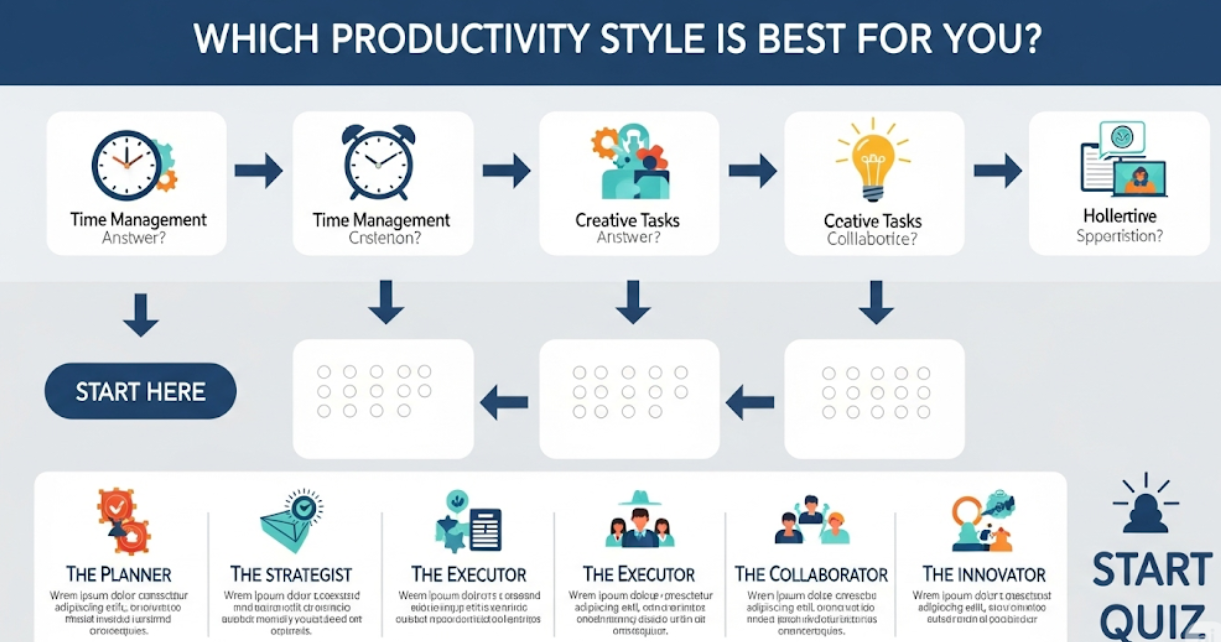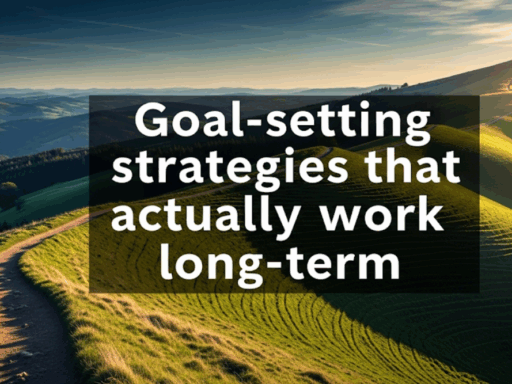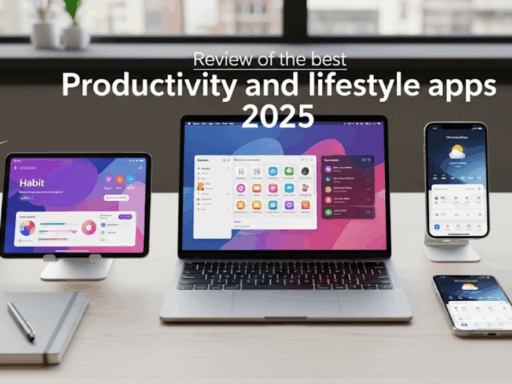What Is Your Productivity Style? [Quiz]
Not everyone has GTD. Maybe your friend likes color-coded planners and a schedule that breaks their day down to the hour, but you do best with to-do lists and working until some kind of spark sets you off into a creative frenzy. It can truly revolutionize the way you work, study and get things done.
By the end of this definitive guide you will know what productivity system suits your personality, work habits, routines and lifestyle. We are going to take you through six of the main productivity styles, give you an extensive quiz to find out your productivity style and provide practical tips as the best way to be more effective.
Science of the Individual Productivity Styles
When we look into research, there is not a square peg in every round hole as far as productivity goes. The brain is a background cacophony of brain chemistry, personality traits, and life circumstances all determining how you best work. Morning people and night owls exist. All cannot manage the same under stress and relaxed environments.
What you must do is align your natural tendencies with productivity systems that actually work. Align your work style with your personality and you will see:
- Less stress and burnout
- Better focus and concentration
- Improved work-life balance
- Higher quality output
- Greater job satisfaction
Six Major Productivity Styles Explained
The Time Blocker
Time blockers are fans of structure and extensive planning. They compartmentalize their entire day to block time for everything and working off schedule is not often done.
Key characteristics:
- Relies on elaborate calendars and scheduling apps
- Arranges even the simplest of tasks days, weeks, or months ahead of time
- Anxious without a schedule
- Works best with predictable routines
- Likes to start and complete a task rather than doing too many at once
Top tools: Google Calendar, Outlook, Clockify (Time blocking app)
Best for: Project managers, executives, students with many courses
The List Master
Writing everything down puts list masters at ease. Often with a long written to-do list that they love checking off, they lead them to have generally good order in their preferences.
Key characteristics:
- Lists, lists, lists (groceries, tasks at work for the week, to-do lists for your weekends)
- Likes crossing an item off your list
- Divide large projects into smaller, manageable pieces
- Procrastinates on tasks that are not written down
- Needs simple task lists to not feel overwhelmed
Best tools: Todoist, pen and paper, bullet journals
Good for: Admins, researchers, super detail-oriented folks
The Sprinter
Sprinters work in intense bursts of activity followed by rest periods. They make the most of energy available when energy is on an uptick.
Key characteristics:
- Periods of high-energy focus
- Engages in regular work breaks
- Struggles with long, monotonous tasks
- Performs well under deadlines
- Prefers variety in daily activities
Top tools: Pomodoro Timers, Forest App, Time Tracking Software
Who should use this: Creative professionals, writers, programmers and founders or any entrepreneur
The Multi-Tasker
Juggling multiple simultaneous projects is second nature; you thrive in an environment of constant variety.
Key characteristics:
- Runs multiple projects concurrently
- Easily bores working on any one task for more than a short while
- Thrives in fast-paced, changing environments
- Easily able to switch forms of work
- Has trouble finishing long-term projects
Top tools: Trello, Asana and digital dashboards or multiple browser tabs
Perfect for: Marketing professionals, consultants, customer service reps
The Minimalist
Minimalists tend to prefer a system with as few tools or complex processes. They are extremely results-oriented individuals, and remove noise.
Key characteristics:
- Uses simple, streamlined productivity methods
- Avoids complicated apps or systems
- Focuses on high-impact activities only
- Frequently delegates some work or tasks
- Work output reflects quality, not quantity
Tools of the trade: Plain old notebooks, simple calendars, The “Getting Things Done” (GTD) method
For: Freelancers, consultants, remote workers, lifestyle minimalists
The Collaborator
Collaborators are great at staying connected to others. Using a combination of accountability partners, teamwork, and social interaction they all but force productivity.
Key characteristics:
- Collaborative team player
- Benefits from external accountability
- Procrastinates when working alone
- Shares goals and progress with others
- Finds motivation through social interaction
Preferred work applications: Slack, Microsoft Teams, shared Google Docs; accountability tools — StickK
Perfect for: Sales teams, marketing departments, teachers, social workers
Quiz: Find Out Your Productivity Style
Answer these 20 questions honestly. Make note of your responses — we’ll give you a total at the end.
Question 1: What is your preferred way to start your day?
- A) Review detailed scheduling calendar
- B) Review comprehensive to-do list
- C) Start with what comes first or seems most interesting
- D) Scan all current projects quickly
- E) Target the single task which will get me results
- F) Communicate with team members/colleagues
Question 2: How do you deal with unexpected tasks?
- A) I book it in my calendar right away
- B) I put it on a to-do list with a due date
- C) Do it now or you never will
- D) Get started and keep your other projects going
- E) Think twice before adding it
- F) Have others help weigh priorities
Question 3: How do you handle large projects?
- A) Plan it over days/weeks
- B) Create a detailed list of every single step
- C) Tackle it in intense sessions when I’m motivated
- D) Work on it while balancing everything else I have going on
- E) Strip it down to the core parts and focus on what really matters
- F) Find someone to collaborate with or get updates from
Question 4: What comes to mind when we say the perfect working environment?
- A) Quiet and structured space with a posted schedule
- B) Workstation with lists & notes visible
- C) Flexible space that I can change if needed
- D) Busy space with multiple screens and projects
- E) Minimalist, clean area
- F) Space to collaborate and interact with others
Question 5: How do you feel about meetings?
- A) They are fine when they are in my calendar
- B) Great if it produces action items at the end
- C) Quick, sharp meetings when I am switched-on
- D) They give me a break and mix up my day
- E) Avoid them unless absolutely necessary
- F) Love a good collaborative problem-solving meeting
Question 6: What is your biggest motivational factor?
- A) Getting my work done as planned
- B) Crossing things off my list
- C) Deadline pressure makes me feel alive
- D) Variety in my work
- E) Producing significant results efficiently
- F) Sharing the experience with others
Question 7: How do you handle interruptions?
- A) They are stressful because they break my schedule
- B) They get added to the list for later
- C) They are handled right away if they look interesting
- D) I don’t mind changing activities
- E) They are kept as low as possible
- F) I like them, especially if it involves helping colleagues
Question 8: What’s your relationship with deadlines?
- A) Close deadlines make me schedule work backward
- B) I break important tasks into mini-deadlines
- C) I usually work best with close deadlines which create urgency
- D) I handle multiple deadlines at once
- E) I set early deadlines for myself to finish early
- F) Team accountability around deadlines makes me do better work
Question 9: How would you like to monitor your progress?
- A) Time-blocked calendar including both completed and upcoming tasks
- B) Completed items crossed off in detailed lists
- C) Bursts of high-energy followed by rest periods
- D) Progress along many fronts simultaneously
- E) Clear tracking of key results accomplished
- F) Shared progress reports for teammates or partners
Question 10: What is the hardest part of productivity for you?
- A) When unexpected events interrupt my schedule
- B) Forgetting tasks that I don’t write down
- C) Concentrating during low-energy periods
- D) Juggling too many projects at once
- E) Doing work which doesn’t contribute real value
- F) Finding motivation while working alone
Question 11: How far in advance do you plan?
- A) Weeks or months ahead, with a detailed schedule
- B) I plan each day and the week as well
- C) Loose planning and focus on what matches my energy & mood
- D) Several projects are planned at different times
- E) I only plan things that must be planned
- F) I coordinate when others have a share in my work
Question 12: Describe your perfect productivity app:
- A) Advanced calendar with time blocking
- B) Comprehensive task management tool with lists and categories
- C) Timer with break prompts
- D) Dashboard showing projects and their statuses
- E) Minimalist design which focuses on essential tools only
- F) Sharing functions to allow teamwork
Question 13: What do you do on low-motivation days?
- A) I push through and stick to my schedule
- B) I tackle smaller tasks from my list until momentum returns
- C) I rest and recharge
- D) I shift focus to a different project that seems more exciting
- E) I identify the one major task I need to complete & work on only that
- F) Contact colleagues or accountability partners
Question 14: How do you manage email and messaging?
- A) I check and respond at set times
- B) Important emails go on my to-do list for follow-up
- C) I respond when the moment feels right
- D) I check multiple times daily during other work tasks
- E) Minimal reliance on email; keep communication streamlined
- F) Prefer chat-like messaging and group conversations
Question 15: How do you celebrate finished work?
- A) Seeing all these time blocks on my calendar filled with completed work
- B) Seeing checked-off task lists
- C) Taking breaks when I truly need them after pushing through
- D) Feeling ready to start a new project
- E) Delivering high-quality results
- F) Talking about accomplishments and progress with team members or friends
Question 16: What makes you most stressed about work?
- A) Not being able to predict timing
- B) Missing important things
- C) Being expected to work when I am too tired
- D) Needing singular focus for too long
- E) Unnecessarily complicated/busy tasks
- F) Working without team support
Question 17: How is it best for you to acquire new skills?
- A) Taking it through scheduled classes/structured programs
- B) Breaking skills into step-by-step learning tasks
- C) Attending intense learning sessions when I’m motivated
- D) Rotating between different learning resources and methods
- E) Focusing on core concepts, skipping unnecessary details
- F) Collaborative learning
Question 18: What is your ideal work schedule?
- A) Set schedule
- B) Flexible schedule
- C) Based on personal energy
- D) Variety of work
- E) High-impact only
- F) Team time
Question 19: How do you handle competing priorities?
- A) I prioritize them based on deadlines and importance
- B) I add them to different lists by type and work through each one
- C) I address whatever seems most pressing or exciting at the time
- D) I multitask all the important things
- E) I eliminate the stuff that can probably be removed for now
- F) I check with another person for their opinion
Question 20: What does productivity success look like to you?
- A) Doing what I said I would when I am supposed to
- B) Getting all the things on my list done
- C) Doing productive work when high-energy
- D) Making consistent progress across categories
- E) Accomplishing goals efficiently
- F) Having strong relationships and meeting deliverables
Scoring Your Quiz
How many times did you choose each letter?
- A: __ (Time Blocker)
- B: __ (List Master)
- C: __ (Sprinter)
- D: __ (Multi-Tasker)
- E: __ (Minimalist)
- F: __ (Collaborator)
Your highest number of responses is your productivity style. If you have a tie, you might be a hybrid!

Maximizing Your Productivity Style
For Time Blockers
Strengths to leverage:
- Intuitive capability to estimate time requirements
- Excellent at meeting deadlines
- Creates predictable, sustainable work rhythms
Areas to improve:
- Leave time unscheduled to handle unexpected tasks
- Build buffer time between scheduled blocks
- Learn to say no to things that are not on your calendar
Recommended tools:
- Google Calendar with color coding
- Calendly for scheduling meetings
- Clockify for time-blocking apps
For List Masters
Strengths to leverage:
- Great for breaking down large projects
- Natural ability to prioritize tasks
- Strong attention to detail
Areas to improve:
- Start by doing the most important things first
- Give tasks deadlines so you won’t keep planning forever
- Use platforms that sync across all devices
Recommended tools:
- Todoist with project templates
- Notion for comprehensive task management
- Physical bullet journal for that tactile satisfaction
For Sprinters
Strengths to leverage:
- High-quality output during focused work periods
- Natural ability to work under pressure
- Outstanding for creative work and problem-solving
Areas to improve:
- Create routines around routine tasks
- Track peak energy to target productive time zones
- Set a routine for tasks that require concentration
Recommended tools:
- Pomodoro timer apps such as Focus Keeper
- Energy tracking apps
- Noise-cancelling headphones for deep work
For Multi-Taskers
Strengths to leverage:
- Ability to handle diverse responsibilities
- Quick adaptation to changing priorities
- Strong crisis management skills
Areas to improve:
- Set boundaries to avoid overcommitment
- Single-task for complex or creative work
- Systematize progress tracking across projects
Recommended tools:
- Asana or Monday.com project management software
- Digital dashboard displaying all current projects
- Time-tracking tools to see where you are spending attention
For Minimalists
Strengths to leverage:
- Focus on high-impact activities
- Efficient use of time and resources
- Natural ability to eliminate distractions
Areas to improve:
- Ensure important, but non-urgent tasks don’t fall through the cracks
- Create easy-to-follow processes for time-consuming admin tasks
- Balance simplicity with necessary complexity
Recommended tools:
- Apple Notes or Google Keep for simple apps
- The “Getting Things Done” methodology
- Habit-tracking apps for routine tasks
For Collaborators
Strengths to leverage:
- Strong teamwork and communication skills
- Natural accountability through relationships
- Inspiring and influencing others to achieve their best
Areas to improve:
- Learn to work independently
- Create personal accountability systems
- Find a middle ground between collaboration and deep work
Recommended tools:
- Team communication: Slack or Microsoft Teams
- Shared project management tools
- Flow Club (Virtual coworking)
Common Productivity Mistakes to Avoid
Forcing the Wrong Style
The single greatest error is to try and apply productivity systems that simply do not leverage your natural working rhythms. As a Sprinter, if you attempt to use the detailed time-block approach for planning your day, it will suffocate and demotivate you. On the opposite side, a Time Blocker utilizing flexible, mood-based systems may experience anxiety and ineffectiveness as well.
Comparing Yourself to Others
The internet is full of productivity influencers who are displaying their pretty planners or Instagram-worthy work environments. Just keep in mind that what they are doing might not be right or work for you. Just concentrate on how you naturally work with things; do not just duplicate what functions for another person.
Over-Complicating Your System
Most of the time people start with a simple productivity method, and over time they begin adding one layer of complexity after another until their system becomes a nightmare. Whether you’re a Minimalist or Multi-Tasker, keep your systems as streamlined as possible while still doing the job you require.
Ignoring Energy Patterns
Natural energy fluctuations benefit all productivity styles. Even Time Blockers will get their best work done by doing the most demanding tasks in their peak energy hours and routine work during their less energetic moments.
Building Hybrid Approaches
The majority of us fall into more than one overarching style. You might be primarily a List Master, but supplemented with Sprinter tendencies during periods of innovation. Here’s how to combine styles properly:
Time Blocker + List Master: Use time blocks for your hours, but inside those blocks list all of the details and tasks that will help make each session productive.
Sprinter + Minimalist: Work in focused bursts but cut out everything else that is not needed.
Multi-Tasker + Collaborator: Balance the completion of many projects while keeping open lines of communication between teammates.
List Master + Collaborator: Create shared task lists and project plans with your team.
Technology and Productivity Styles
Technology plays nicely into different productivity styles:
| Style | Most Popular Apps | Features to Look For |
|---|---|---|
| Time Blocker | Google Calendar, Clockify | Time-blocking, calendar integration, scheduling |
| List Master | Todoist, Any.do | Task hierarchies, due dates, project organization |
| Sprinter | Forest, PomoDone | Timers, break reminders, focus tracking |
| Multi-Tasker | Asana, Trello | Project boards, multiple views & quick switching |
| Minimalist | Apple Notes, Google Keep | Simple interface; minimal features; fast entry |
| Collaborator | Slack, Monday.com | Team features, shared workspaces, communication |
Environment and Productivity
Ensure that the way you work and your productivity style can be practiced within both physical and digital environments:
Time Blockers need an organized area, free of clutter and distractions with calendars visible.
List Masters appreciate having their task lists always visible and accessible, whether through paper or digital displays.
Sprinters need to be able to change environments based on their current energy or the type of work they are doing.
Multi-Taskers do best with multiple screens for multitasking, accessible projects and changing environments.
Minimalists work best on a clean surface where only the essentials are available.
Collaborators must have easy access to communication tools and shared workspaces, either physical or digital.
Adapting Your Style Over Time
Your personal productivity style can change due to:
- Life changes: New job roles, family responsibilities or living situations
- Career progression: Moving from individual contributor roles to management
- Personal growth: New skills and changing priorities
- Health factors: Energy levels, stress, illness or chronic health issues
Always be re-examining your approach and tweaking systems as you go. Your college methods might not work in your first job. What works as a solo freelancer does not always work when you are leading a team.
Making Productivity Sustainable
The most productive system is one that you can sustain over a lifetime without losing your mind. Here are keys to sustainability:
Start small: Instead of changing your whole system, focus on implementing one or two changes at a time.
Build complexity gradually: Start simple and work your way slowly along the line of complexity.
Regular check-ins: Weekly or monthly touchpoints to see what is going well and what needs adjusting.
Allow evolution: Your needs will evolve and you should let your system do so also.
Practice self-compassion: Don’t expect perfection. Embrace the process and progress, not perfection.
Conclusion
Determining your productivity type is not about following the latest trend or doing what worked for someone else. It’s about understanding the natural ways that you operate and work, and designing a system that supports rather than fights against it.
Whether you might be a structured Time Blocker who loves detail, an energetic Sprinter, or a talented Collaborator — we all need to find our own groove that works for us. The right way is the one that allows you to most effectively continue to do meaningful work throughout your career while maintaining a high level of well-being and motivation.
Use the quiz results to guide you in trying out the tools and techniques recommended for your style. Begin gradually and build them into a productivity system you enjoy using. Productivity is not only about doing more, but also about making time for what’s important to you in your work and life.
Your self-discipline and motivation may be your best assets, yet they are still only one part of the puzzle. Combine this with clear goals, healthy habits and daily reflection to create a recipe for achieving productive success. The goal is not to be busy — it is to be productive, fulfilled and balanced in your work.




